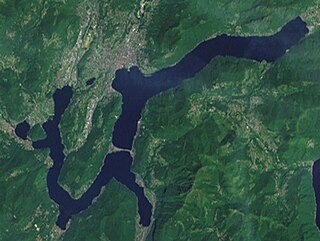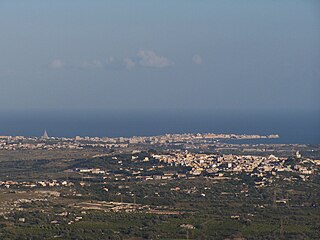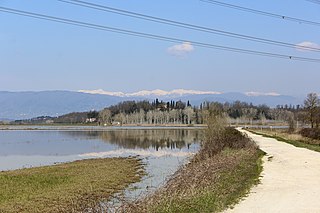
Sicily is the largest island in the Mediterranean Sea and one of the 20 regions of Italy. It is one of the five Italian autonomous regions and is officially referred to as Regione Siciliana. The region has 5 million inhabitants. Its capital city is Palermo.

Lombardy is one of the twenty administrative regions of Italy, in the northwest of the country, with an area of 23,844 square kilometres (9,206 sq mi). About 10 million people live in Lombardy, forming more than one-sixth of Italy's population, and more than a fifth of Italy's GDP is produced in the region, making it the most populous, richest and most productive region in the country. It is also one of the top regions in Europe for the same criteria. Milan's metropolitan area is the largest in Italy and the third most populated functional urban area in the EU. Lombardy is also the Italian region with most UNESCO World Heritage Sites—Italy having the highest number of World Heritage Sites in the world. The region is also famous for its historical figures such as Virgil, Pliny the Elder, Ambrose, Caravaggio, Claudio Monteverdi, Antonio Stradivari, Cesare Beccaria, Alessandro Volta, Alessandro Manzoni, and popes John XXIII and Paul VI.

Reggio di Calabria, commonly known as Reggio Calabria(listen) or simply Reggio in Southern Italy, is the largest city and the most populated comune of Calabria. It is the capital of the Metropolitan City of Reggio Calabria and the seat of the Regional Council of Calabria.

Naples is a metropolis in Italy. It is the regional capital of Campania and the third-largest city of Italy, after Rome and Milan, with a population of 967,069 within the city's administrative limits as of 2017. Its province-level municipality is the third-most populous metropolitan city in Italy with a population of 3,115,320 residents, and its metropolitan area is the second-most populous metropolitan area in Italy and the 7th-most populous urban area in the European Union.

Cisterna di Latina is a town and comune in the province of Latina in Lazio, of central Italy. It was the scene of the Battle of Cisterna in January 1944.

Lake Lugano is a glacial lake which is situated on the border between southern Switzerland and northern Italy. The lake, named after the city of Lugano, is situated between Lake Como and Lago Maggiore. It was cited for the first time by Gregory of Tours in 590 with the name Ceresio, a name which is said to have derived from the Latin word cerasus, meaning cherry, and refers to the abundance of cherry trees which at one time adorned the shores of the lake. The lake appears in documents in 804 under the name Laco Luanasco.

Caronia is a town and comune on the north coast of Sicily, in the province of Messina, about half way between Tyndaris and Cephaloedium. The town has 3,555 inhabitants.

Southern Italy or Mezzogiorno is a macroregion of Italy meant to broadly denote the southern half of the Italian state.

The Province of Syracuse is a province in the autonomous island region of Sicily in Italy. Following the suppression of the Sicilian provinces, it was replaced in 2015 by the Free municipal consortium of Syracuse. Its capital is the city of Syracuse, a town established by Greek colonists arriving from Corinth in the 8th century BC. It has an area of 2,109 square kilometres (814 sq mi) and a total population of 403,985 (2016). Syracuse has 8% of the Sicilian population and 8.2% of Sicily's area.

Ducetius was a Hellenized leader of the Sicels and founder of a united Sicilian state and numerous cities. It is thought he may have been born around the town of Mineo. His story is told through the Greek historian Diodorus Siculus in the 1st century BCE, who drew on the work of Timaeus. He was a native Sicilian, but his education was Greek and was very much influenced by Greek civilization in Sicily. He is sometimes known by the Hellenized name of Douketios.

Malcesine is a comune (municipality) on the eastern shore of Lake Garda in the Province of Verona in the Italian region Veneto, located about 120 kilometres northwest of Venice and about 40 kilometres northwest of Verona.

Guardialfiera is a comune (municipality) in the Province of Campobasso in the Italian region Molise, located about 30 kilometres (19 mi) northeast of Campobasso. It sits on a hilltop overlooking Lake Guardialfiera, which was created as a result of the damming of the Biferno river.

Sambuca di Sicilia is a comune (municipality) in the Province of Agrigento in the Italian region Sicily, located about 68 kilometres (42 mi) southwest of Palermo and about 89 kilometres (55 mi) northwest of Agrigento.

Lago di Bientina, also known as Lago di Sesto, was a lake in Tuscany, Italy. Located to the north of the town of Bientina, between Lucca and Pisa, the lake was historically subject to numerous efforts at drainage due to its tendency to flood. Early attempts at canal-building and drainage in the 16th century were hampered by the lake's connection with the Arno River, which often led to backflow and even increased flooding.

Lentini, historically Leontini or Leontinoi, is a town and comune in the Province of Syracuse, South East of Sicily.
Democratic Sicily was a regional centrist Italian political party active in Sicily.

Sicula Leonzio, also commonly known as Leonzio, is an Italian football club located in Lentini.

The Tunnels of Claudius are a hydraulic work made up of a long underground canal, six inclined service tunnels and thirty-two wells, which Emperor Claudius had built between 41 and 52 AD to control the variable levels of the Fucine Lake in Abruzzo, thus protecting riparian villages from floods and reclaiming the Fucine lands making them cultivable. Thanks to them, the lake waters flowed out through the belly of Mount Salviano from the Avezzano side along the almost 6-kilometre-long (3.7 mi) tunnel until they flowed into the Liri River on the opposite side of the mountain, under the old town of Capistrello. The underground canal represents the longest tunnel ever built since ancient times until the inauguration of the Fréjus Rail Tunnel occurring in 1871.

The Chiesa madre of Santa Maria la Cava e Sant'Alfio is the main religious building in Lentini, Italy.

Maccarese is a locality in Lazio, Italy, in the Metropolitan City of Rome. It is administratively divided between the Municipalities of Rome and Fiumicino, of which it is a frazione.
It was entirely part of the Municipality of Rome until 1993, when the former Circoscrizione XIV, which included a part of the hamlet, became the autonomous Municipality of Fiumicino.




















